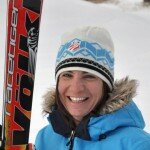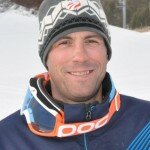About Us
Team Vision 4 Gold
Danelle Umstead
Danelle is a wife, mother, and visually impaired ski racer. She is going blind to a disease called Retinitis Pigmentosa. Recently she has lost most of her peripheral vision to this disease.  Retinitis pigmentosa (RP) is a group of inherited diseases that damage the light-sensitive rods and cones located in the retina, the back part of our eyes. Rods, which provide side peripheral and night vision, are affected more than the cones which provide color and clear central. Unfortunately Danelle has no central vision or depth perception in both eyes caused by early onset macular degeneration. This makes her situation a lot worse than most. There is no chance of return vision, nor is there a cure. Danelle spent many years feeling sorry for herself, not having a sense of worth to her life. She truly believed without sight she could not do anything.
Retinitis pigmentosa (RP) is a group of inherited diseases that damage the light-sensitive rods and cones located in the retina, the back part of our eyes. Rods, which provide side peripheral and night vision, are affected more than the cones which provide color and clear central. Unfortunately Danelle has no central vision or depth perception in both eyes caused by early onset macular degeneration. This makes her situation a lot worse than most. There is no chance of return vision, nor is there a cure. Danelle spent many years feeling sorry for herself, not having a sense of worth to her life. She truly believed without sight she could not do anything.
In 2000 she started adaptive skiing with her father as her first guide in Northern New Mexico. It opened her eyes to a world of opportunities. In 2001 moved from Plano, TX to Taos, NM. Now she could be closer to Taos Ski Valley and her family too. She worked at the mountain so she could ski more (with her father, friends, and other employees guiding her). Danelle said “skiing has given me new meaning and value to life, in more ways than the sport itself”. Despite her progressively worsening vision Danelle wanted to go steeper and faster the more she skied. Life did a full circle for Danelle, despite the constant struggles that every blind/visually impaired person goes through on a daily basis – Her life was just beginning. Danelle met her best friend/future husband Rob at Taos Ski Valley after a day of skiing with a friend. He was offered a coaching job in Park City, Utah, and asked Danelle to go with him. There she started training with the National Ability Center Ski team, going through several guides. In Danelle’s first full season of racing in Park City, Utah she competed in Slalom and Giant Slalom. At the 2008 US Disabled Nationals, Danelle and part time guide Sally Tauber won Bronze medalist’s in both events.
One of the biggest struggles with any VI skier is to find a full time guide, and this is a major component to success. A VI ski racer can only make it so far without a guide who can commit to training, traveling and competing full time. To compete at the highest level Danelle needed to have a full time guide with a vested interest in her and the sport. Rob, Danelle’s husband started guiding/ training with her full time in the summer of 2008. They competed 2008-2009 with unbelievable results. Team Vision4Gold is going to the 2010 Paralympic’s as one of the top contenders. See the result page for rankings and their results. Danelle now believes without vision you can do anything, it is just done differently.
Rob Umstead
Rob has been involved in the sport of ski racing for 23 years. He started as a young athlete in Vermont and moved on to be a college racer for the University of Massachusetts. Since college, Rob has been a race coach in New Hampshire, New Mexico, Utah and summers on Mt. Hood Oregon.
in Vermont and moved on to be a college racer for the University of Massachusetts. Since college, Rob has been a race coach in New Hampshire, New Mexico, Utah and summers on Mt. Hood Oregon.
Rob watched his wife struggle for consistency in a guide in her first few seasons. In the 2008/09 season he decided to be part of her” vision” and committed himself to guiding her full time.
He enjoys being back on the athlete side of the race course and thrives on the training and the challenges that go into being a successful Visually Impaired (VI) team.
Multiple Sclerosis
Multiple sclerosis (or MS) is a chronic, often disabling disease that attacks the central nervous system (CNS), which is made up of the brain, spinal cord, and optic nerves. Symptoms may be mild, such as numbness in the limbs, or severe, such as paralysis or loss of vision. The progress, severity, and specific symptoms of MS are unpredictable and vary from one person to another. Today, new treatments and advances in research are giving new hope to people affected by the disease. - National Multiple Sclerosis Society
Multiple sclerosis (abbreviated MS, also known as disseminated sclerosis orencephalomyelitis disseminata) is an inflammatory disease in which the fatty myelin sheaths around the axons of the brain and spinal cord are damaged, leading to demyelination and scarring as well as a broad spectrum of signs and symptoms.[1] Disease onset usually occurs in young adults, and it is more common in women.[1] It has a prevalence that ranges between 2 and 150 per 100,000.[2] MS was first described in 1868 by Jean-Martin Charcot.[3]
MS affects the ability of nerve cells in the brain and spinal cord to communicate with each other. Nerve cells communicate by sending electrical signals called action potentials down long fibers called axons, which are wrapped in an insulating substance called myelin. In MS, the body's own immune system attacks and damages the myelin. When myelin is lost, the axons can no longer effectively conduct signals.[4] The name multiple sclerosis refers to scars (scleroses—better known as plaques or lesions) particularly in the white matter of the brain and spinal cord, which is mainly composed of myelin.[3] Although much is known about the mechanisms involved in the disease process, the cause remains unknown. Theories includegenetics or infections. Different environmental risk factors have also been found.[4][5]
Almost any neurological symptom can appear with the disease, and often progresses to physical and cognitive disability.[4] MS takes several forms, with new symptoms occurring either in discrete attacks (relapsing forms) or slowly accumulating over time (progressive forms).[6] Between attacks, symptoms may go away completely, but permanent neurological problems often occur, especially as the disease advances.[6]
There is no known cure for multiple sclerosis. Treatments attempt to return function after an attack, prevent new attacks, and prevent disability.[4] MS medications can have adverse effcts or be poorly tolerated, and many patients pursue alternative treatments, despite the lack of supporting scientific study. The prognosis is difficult to predict; it depends on the subtype of the disease, the individual patient's disease characteristics, the initial symptoms and the degree of disability the person experiences as time advances.[7] Life expectancy of patients is 5 to 10 years lower than that of the unaffected population. - Wikipedia
About The Paralympics
Danelle and Rob compete in the VI alpine ski events during the Winter Paralympic Games. If you’re not
familiar with the Paralympic Games, read on…
Who can participate?
The Paralympic Games are for elite athletes with physical disabilities. Disability categories include:
-
visually impaired (VI)
-
amputee
-
spinal injuries
-
cerebral palsy
-
“les autres,” encompassing physical disabilities such as Dwarfism and Multiple Sclerosis.
When and where do they happen?
The Winter Paralympics take place two weeks after the Olympics; same goes for the Summer Paralympics. The Paralympic Games are held in the same location, at the same venues, as the Olympic Games.
Do athletes compete for medals?
Just as in the Olympics, athletes compete for Gold, Silver and Bronze medals.
Which sports are included in the Winter Paralympic Games?
The Winter Paralympic Games feature five sports:
-
Alpine Skiing, including downhill, Super-G, Super Combined, Giant Slalom and Slalom events
-
Cross country, or Nordic, Skiing
-
Biathlon
-
Sled Hockey, also known as ice sledge hockey
-
Wheelchair Curling
Both alpine and Nordic Skiing are further separated into “standing,” “sitting” and “visually impaired” categories to fairly match athletes against like abilities.
How many athletes compete?
In Vancouver (2010), more than 600 athletes from 40 countries competed. 13 women and 37 men represented Team USA.
What is next for Team Vision4Gold and Team USA?
-
2011-12 World Cups
-
2013 World Cups and World Champs
-
Sochi, Russia 2014!
Resources:
Retinitis pigmentosa
Retinitis pigmentosa (RP) is a group of genetic eye conditions that leads to incurable blindness.[1] In the progression of symptoms for RP, night blindness generally precedes tunnel vision by years or even decades. Many people with RP do not become legally blind until their 40s or 50s and retain some sight all their lives.[2] Others go completely blind from RP, in some cases as early as childhood. Progression of RP is different in each case.
RP is a type of progressive retinal dystrophy, a group of inherited disorders in which abnormalities of the photoreceptors (rods and cones) or the retinal pigment epithelium (RPE) of the retina lead to progressive visual loss. Affected individuals first experience defective dark adaptation or nyctalopia (night blindness), followed by reduction of the peripheral visual field(known as tunnel vision) and loss of central vision. - Wikipedia
About VI Skiing
What is VI Skiing?
Visually Impaired, or “VI”, skiing means that the athlete is either totally blind, or has reduced visual acuity or visual field. VI skiers use the same equipment (skis, poles) as skiers without disabilities, but ski with a guide who provides verbal cues for following the course.
What is Retinitis Pigmentosa and how does that affect Danelle’s vision while skiing?
Retinitis Pigmentosa is a genetic eye condition where the retina progressively degenerates and eventually causes blindness. Danelle has “spotted vision” and can only see up to five feet in front of her. Even then, she can only see contrasting colors without any level of detail.
Most people with disabilities have the same disability all the time – for Danelle, her vision is never the same, always changing and often getting worse due to the light conditions. Danelle “appreciates every bit of light that comes in through my eyes. There will be darkness. I just don’t know if it’s tomorrow or another five years from now.”
How is the skier able to ‘see’ and communicate with the guide?
Danelle’s husband and guide, Rob, helps her navigate the course with a combination of physical and communication aids:
Contrasting bib. Rob wears a dark racing suit and bright orange tee shirt and bib, creating a high-contrast target that Danelle can spot as she skis behind.
Headsets for constant communication. Both Danelle and Rob wear motorcycle headsets (from Cardo Systems), which are attached to their ski helmets. Danelle cannot ski without these and luckily, they are bomber – reliable in snow, wet conditions, even crashes! Rob is constantly communicating about where to turn and what she’ll feel with the terrain, keeping Danelle on course even if she loses sight of him. This open line of communication – translating every “step” down the mountain – is essential for any VI team.
Trust. When sight is limited – or totally gone – you have nothing if you don’t have trust. Danelle trusts Rob 100%, a cornerstone of Team Vision4Gold.
What makes for a successful skier-guide pairing?
Back to trust. With as low vision as Danelle has, trust between her and her guide is the foundation of their ski racing… (just so happens, of their marriage too!). Understanding each other’s language, open communication and consistency are also critical ingredients for success.
